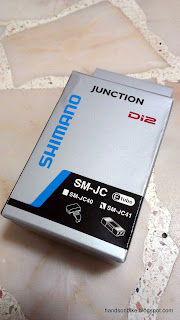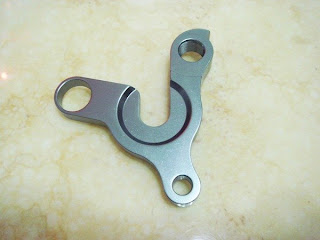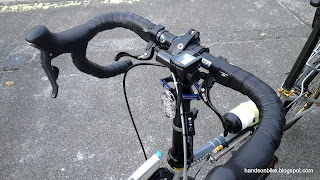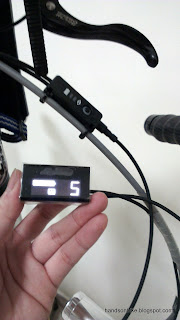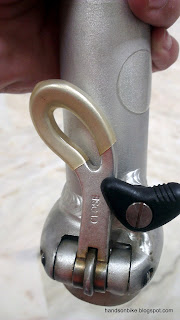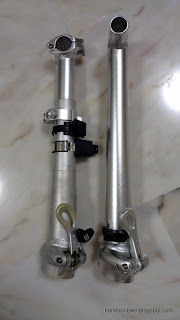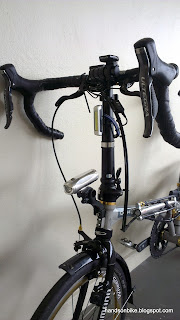Do you own a Dahon or Tern folding bike? Do you want to upgrade the components on your folding bike? If the answer is yes, then you have come to the right place! On this blog, there is plenty of info for those who want to know more about folding bike upgrades. However, I also understand that most of the info is scattered all over the place, and that it can be difficult to find the answer to your upgrade question. Also, I have been receiving quite a few questions regarding upgrading a Dahon / Tern bike. Therefore, I have decided to create a simple guide for those who plan to upgrade their Dahon or Tern folding bike.
For real examples of upgrades, please refer to
Dahon Boardwalk Di2 or
Dahon Vitesse X20-TT for details.
Question: Can these bikes be upgraded easily? Dahon Eco C6 and Dahon Boardwalk D7
This upgrading guide is specially written for Dahon or Tern bike users, as I am more familiar with the folding bikes from those 2 brands, and have some experience myself in upgrading Dahon bikes. However, this does not mean that it is totally irrelevant to other folding bike brands! Some of the pointers may well apply to other bike brands, as many bicycle components are actually quite similar across brands and models.
For this guide, the different components that are available for upgrade will be discussed separately, along with my recommendations and the expected cost of upgrade. At the end of the day, this guide is meant to help you determine if the bike that you have can or cannot be upgraded easily, and at what cost.
Index:
a) Wheelsetb) Cassettec) Crankset / Bottom Bracketd) Rear Derailleure) Front Derailleurf) Handlepost / Handlebarg) Shifters / Brake Leversh) Brake Calipers Wheelset
The wheelset is one of the key components of a bike. With a good lightweight wheelset with smooth bearings, getting the bike up to speed definitely feels easier. However, this is also one of the main limiting factors for upgrade.
In terms of upgrade possibilities, there is a huge difference between a 7 speed and a 8 speed bike. This is because of the different freehub body on the rear wheel. For a 7 speed bike such as the Dahon Vitesse D7, DrHon Vybe C7, or Tern Link C7, it cannot be upgraded to 8 speeds and above without changing out the rear wheel which usually also means the entire wheelset.
However, if you get a 8 speed bike, such as Dahon Speed P8 or Tern Link D8, you can upgrade easily to 9 or 10 speeds. This is because 8/9/10 speed freehub bodies are the same, thus you can fit on 8/9/10 speed cassettes.
Stock wheelset from Dahon D7 series.
Kinetix Comp wheelset, comes stock with Dahon 8 speed bikes.
Although the wheelsets look very similar, the freehub body length is different, which means a big difference in terms of upgrade possibilities.
Tern Link C7. Cannot upgrade to 8/9/10 speeds without changing the wheelset. However, it does have a standard DATT RD hanger which allows upgrades to the RD (more details below).
Tern Link D8. Can upgrade to 8/9/10 speeds without changing wheelset. However it does not have a standard DATT RD hanger.
Recommendation:Unless you are getting a basic bike with zero intention of upgrading your bike, you should get a bike model with at least 8 speeds. It is worth the initial investment as it allows you to transit from 8 to 9 or 10 speeds much more easily.
Take note that you can only fit front hubs with 74mm OLD, not the standard 100mm used by most full sized bikes. Thus your wheelset choices are pretty limited (but still much better than previously, where only Kinetix wheelsets are available.)
Cost:If you have a 7 speed bike, you will need a new wheelset if you intend to upgrade to 8/9/10 speeds. A basic Kinetix Comp wheelset will cost at least $200 second hand, or $300+ brand new.
Mid to high range wheels such as Wheelsport or Kinetix Pro cost $400-$600++. There are also high profile carbon wheelsets by Controltech that cost over $1000.
Cassette
The cassette is the name for the collection of sprockets located on your rear hub. The number of sprockets determine the number of speeds that your bike can have. It is closely linked to the type of wheelset and freehub body that you have.
7 speed freehubs can only fit 7 speed cassettes, while 8/9/10 speed cassettes share the same freehub body dimensions. Thus if your wheelset can fit 8 speed cassettes, it means that you can also fit 9 or 10 speed cassettes on the same wheelset.
How do 8, 9 and 10 speed cassettes fit on the same freehub body length? This is possible as 9 speed sprockets and spacers are thinner than 8 speed ones, which allow 1 more sprocket to fit in the same space. Same concept for 10 speed cassettes, where the sprockets are even thinner and closer to each other.
Stock 7 speed cassette from Dahon Boardwalk (2010).
9 speed SRAM road cassette
Recommendation:Nowadays, it is getting harder to find aftermarket 8 speed cassettes, as most of the market has moved to 9 speeds and above. Development for 8 speed drivetrain has mostly stopped.
Thus, if you are thinking of upgrading from 7 to 8 speeds (with purchase of new wheelset), I would suggest going straight to 9 or more speeds. Although it is slightly more costly, you have a much wider range of shifters and derailleurs to choose from.
Choose an appropriately sized cassette for your riding style. If you do not have a powerful engine, you may want to get cassettes with a larger sprocket (Eg. 11-28T or 12-30T) to help you climb up the slopes.
Do note that when you change cassettes, the chain also has to be changed to match the speed. Do not use a 8 speed chain on a 9 speed cassette as there will be shifting problems and lots of noise.
Cost:From $25 for a new 8 speed cassette to ~$60 for a Shimano 105 10 speed cassette. Higher grades of cassettes are available, but are much more costly. The main difference for the higher cost is reduced weight.
Crankset/Bottom Bracket
This is another component that many people like to upgrade. Not only can you save a surprising amount of weight, it can improve the pedaling feeling tremendously and also create a fresh new appearance for the bike. The crankset is one of the most important component on a bike in terms of appearance, as most people will look at the crankset when they first look at a bike.
Almost all of the entry to mid range folding bikes come with standard square taper cranksets with a square taper BB. Even high end folding bikes rarely use other cranksets due to cost. The square taper crankset has been around for quite a while, and is a standard on most bikes costing below $1000. The drawback of a square taper crankset is that the stiffness is not as good, as the bearings sit more narrowly inside the frame instead of outside the frame. Another reason is because a square taper BB has a narrower spindle than a Hollowtech II crankset, which means more flex. Weight is also much heavier as compared to newer cranksets.
Stock square taper crankset + BB from Dahon D7 bike. Weight is around 1200 grams.
Shimano Hollowtech II crankset + BB. For Ultegra FC-6700, the weight including BB is around 800 grams.
Luckily almost all Dahon / Tern bike frames use standard BB shells on their frames, so it will take all BB with standard dimensions and threads. If in doubt, just consult a bike shop.
Recommendation:When upgrading the crankset, go for something with quality as you can feel the difference and will appreciate the improved performance. No point changing from a square taper crankset to another square taper crankset, you will not find any big difference other than appearance.
Other middle range standards such as ISIS or Octalink are not commonly found, you are likely to be better off upgrading to a Hollowtech II system.
Cranksets that use outboard bearings include Shimano Hollowtech II or SRAM BB30. These new designs use outboard BB bearings for better rigidity and durability.
Go for a road crankset with 52T and more, as you will need the larger chainring for small wheeled folding bikes. Avoid MTB cranksets as the chainring is too small to give a good gear ratio.
Using 9 or 10 speed cranksets does not really matter, unless you are thinking of fixing a front derailleur. A 10 speed crankset will run an 8 speed chain with no major issue, although chain drop may sometimes occur.
Cost:$100+ for a Tiagra 10 speed crankset, to
$300+ for an Ultegra crankset. Higher end cranksets are lighter in weight due to hollow crank arms and better material used. Find one that suits the style and colour of your bike. Once again, if in doubt, consult the bike shop.
Rear Derailleur
This component is another hot component for upgrades. As the RD is closely linked to shifting performance, many people want to upgrade their RD when they upgrade their bikes with more speeds. Unfortunately for many Dahon / Tern bike users, upgrading the RD can be very troublesome.
Many Dahon / Tern bikes, from entry level to mid-high range bikes, such as D7 or even P9 series, use Dahon / Tern's proprietary Neos rear derailleur. This RD is designed by Dahon and used exclusively on Dahon / Tern bicycles. According to Dahon / Tern, this RD design allows for a low profile RD. You will notice that there is no regular RD hanger on the frame, but a special mounting point located on the chainstay for the RD.
So, if your bike comes with a Neos RD, it is likely that it does not have a normal RD hanger for traditional RD mounting. Sometimes you can find Dahon Speed P8 frames with a Neos RD, but also a RD hanger. This is not so common, probably only available for certain years' model.
In this case, how can you change your RD, since there is nowhere to mount a normal RD with DATT mounting? For Dahon steel frames (Boardwalk, Speed), you will
need a third-party RD hanger to do that. For Dahon aluminium frames (Vitesse, Mu), the plate on the rear dropout can be swapped for a genuine Dahon RD hanger for aluminium frames. However, these mountings can be hard to find, thus posing a barrier to RD upgrade.
Some higher end Dahon frames (such as Vitesse P18 or Vector X10) have normal DATT RD mountings with Shimano rear derailleurs, so no problem with upgrading the RD. Ironically, the entry level Dahon Vybe C7A does not use the Neos RD, and thus it has a standard RD hanger which means an easy RD upgrade (although you need to change wheelset to upgrade to 8/9/10 speeds).
As for Tern bicycles, there is no proper RD hanger to use for now. No third party RD hanger is available currently for Tern bicycles, so you are pretty much stuck with the stock Neos RD unless your bike frame already has a normal DATT RD hanger. An example would be the Tern Link C7 or the Verge series of frames.
Stock Neos RD on Dahon Boardwalk frame. Notice the special mounting point for the RD. No standard DATT RD hanger!
The special RD hanger for Dahon Boardwalk/Speed frames. Mounts cleverly using the original Neos RD bolt hole and the frame eyelets. Dahon Boardwalk frame with the RD hanger and the SRAM X-9 MTB RD.
Dahon Vitesse with a proper RD hanger (bought from MBS), with a normal Ultegra RD.
That said, the stock Neos RD is actually pretty decent. It gives fast shifting, although the gears may sometimes make noise due to looseness in the RD construction. It is also a low-normal design, as opposed to the much more common top-normal design. The stock 7/8 speed Neos RD would probably work up to 9 speeds, but it will not give you optimum performance as it was not designed for 9 speeds (unless you have the premium Neos RD on a Link P9)
Take note that if you use the Neos RD with a conventional non-Dahon / Tern shifter, the gear number indication on the shifter will be reversed. Meaning that the lowest gear on the cassette will show up as gear 9 on the shifter (if a 9 speed shifter is used). Gear shifting will still work normally, only that the indication is reversed. This is due to the low normal construction of the RD (as compared to the common top normal RD construction.
Recommendation:To avoid unwanted hassle when upgrading your RD, look for a folding bike that comes stock with a normal DATT RD hanger. This will save you the trouble when looking for the RD hanger when you want to upgrade. If you can obtain a suitable RD hanger (such as the RD hanger for Vitesse frames), then you are ready to upgrade!
As far as possible, get a road RD, as it has shorter cages that are more suitable for small wheel bikes. Long cage MTB RD should be avoided.
Short cage vs long cage RD.
Cost:Around $25 for the RD hanger, that is if you can even find it in stock. Dahon RD hangers are sometimes available at folding bike shops such as MyBikeShop.
As for the RD, the cost can vary greatly. From $30+ for a 9 speed Shimano Sora RD to $100+ for an Ultegra level RD, they are all pretty decent. Just remember to get the correct RD for your speed, and also the appropriate shifter. Use road shifters for road RD, and MTB shifters for MTB RD. Also, do not mix RD and shifters from different brands as the cable pull ratio is different.
Front Derailleur
Most folding bikes do not come with front derailleurs, as they are not so crucial to the bike. Higher end models of bikes such as Dahon Vitesse P18 or Tern Verge P18 do come with front derailleurs for more speeds.
If your bike comes stock with a front derailleur, then upgrading the front derailleur is easy, just take out the current one and swap in the new one.
However, if your stock bike does not come with a front derailleur mount, adding a front derailleur is much more troublesome.
You will need a FD adaptor, the most common one being the FD adaptor from Litepro.FD Adaptor for Dahon frames. May also fit Tern bikes. The one on the left is for Speed/Vitesse frames, the one on the right for Mu frames.
As mounted on the Dahon Boardwalk seat tube. Quite a bit of adjustment is required to get the setting right.
Recommendation:A front derailleur is usually not crucial. Not an important consideration here, unless you are planning to ride the bike on a variety of terrain, with lots of up and down slopes. In that case, get a bike with a front double crankset. Saves you a lot of time and money as compared to upgrading from front single to front double later on.
Note that not all bikes can be retrofitted with an FD adaptor. Although the Mu frame can technically fit an FD adaptor, it is difficult to mount a FD properly due to the tight frame clearances.
Cost:$30 for a Shimano Sora FD, and $50+ for an Ultegra FD. Front derailleurs are very affordable, and performance is quite similar across the price range. You will not go wrong with a Shimano 105 FD, the most value for money road FD. Stick to front double FD as Dahon / Tern folding bikes cannot accommodate front triple cranksets. Also, use road FD and not MTB FD.
Handlepost/Handlebar
At first glance, this may not seem to be important, as most people will look at the other components when checking out the bikes. However, folding bikes are not normal bikes. Due to its nature of a small frame and the folding feature, practically all folding bikes use a special folding handlepost. Dahon was the first to come out with their hugely successful Radius V handlepost, which combined stiffness and easy folding in one elegant package. Recently, Tern built on the concept and developed the Physis handlepost, which was even stiffer than the Dahon handlepost, but also came with a weight penalty.
As long as you buy a Dahon or a Tern folding bike, you can be sure that you are getting one of the better folding handleposts out there. Higher end models may have a stiffer design, but even the entry level designs are pretty good compared to other folding bike handleposts.
Now, for the tricky part. Although folding handleposts from Dahon and Tern look similar, they are not built the same!
The key part to take note here is how the handlebar is fixed to the handlepost. There are many different systems in use, which will affect the type of handlebar that you can use. Some systems allow any handlebar to be used, while others only allow flat handlebars.
Standard handlepost clamp seen on most Dahon bikes. This clamp opens up fully, so you can also install a bullhorn bar or a drop bar directly in the clamp.
Dahon handlepost clamp that opens up to accept any handlebar.
Handlepost clamp found on the Verge P18. This design is a closed clamp which does not open fully. As such, it can only accept flat handlebars as it is not possible to fit the curvy bullhorn bar or drop bar into the clamp.
This is a feature that is always overlooked when getting a new Dahon / Tern folding bike. If you intend to change out to a bullhorn bar or drop bar in the future, it is best to have a handlepost clamp that can be opened fully. If not, it will be difficult to change to a curvy handlebar.
Fortunately, there are workarounds to this problem.
It involves getting a stem that can also modify the reach at the same time, such as the one from Litepro. As the 2 sides of the stem can be separated, they can be threaded through the curves of the bullhorn or drop bar. The entire stem can then be fixed onto the handlepost clamp.
Litepro Stem used to modify the reach on Dahon / Tern folding bikes.
How it looks like when mounted on a Dahon handlepost clamp.
Recommendation:If you intend to stick to flat handlebars, it does not matter which handlepost you have. However, if you intend to change to bullhorn bars or drop bars in the future, this may pose a problem if you have a closed clamp such as that found on some Tern handleposts.
With the Litepro stem as a workaround, you can still install a curvy handlebar. However, do note that it will also affect the reach at the same time. The stiffness of the handlebar will decrease as there is now one more part linking the handlebar to the handlepost. Usually this will not pose a major issue, unless you are unable to find the stem or if the
stem slips/rotates in the handlepost clamp.Cost:>$100 if you change out the handlepost, such as from an adjustable 2 piece handlepost to a stiffer 1 piece handlepost. $40 for the Litepro stem, and $40 and above for a bullhorn / drop bar.
Shifters/Brake Levers
This is the component that you operate with your hands whenever you ride the bike, unless you ride a single speed or an automatic 2-speed hub such as the Tern Verge Duo. Folding bikes nowadays typically come with 7 speeds for entry level models, up to 20/30 speeds for top end models. To change gears, there are a few type of gear shifters.
1) Revo / Gripshifts Gripshift by SRAM that comes stock with many Dahon / Tern bikes.
Gear changes are made by rotating the gear shifting grip on the handlebar. Found commonly on 7 and 8 speed folding bikes. Advantages of these are that it is lightweight and does not protrude out from the handlebar too much which makes it easier when folding. However they are tricky to operate when travelling at higher speeds, as you do need to relax your grip before shifting.
2) Trigger shiftsShimano XT and SRAM X9 trigger shifters.
The thumb and index finger will push levers that change gears. Found on almost all mountain bikes, but are rather uncommon on Dahon / Tern folding bikes. Many people upgrade to these as they offer a good and ergonomic gear shifting experience. Comes with some mid-range folding bikes such as Dahon Vitesse P18 / Tern Verge P18.
3) Road Dual Control Levers (DCL)Shift by pushing the main or release lever inwards with the fingers.
Road shifters used on bullhorn or drop bars. Most of the models combine shifting and braking functions together in the same part, hence dual control levers. Comes standard on folding bikes with drop bars / bullhorn bars. Cannot be used on flat handlebars.
4) Bar end shiftersBar end shifters. Flick the lever up or down to change gears.
Quite uncommon nowadays, but still popular with some people due to its small size and retro feel. Fixed onto the end of bullhorn or handlebars. May be tricky to use as it involves taking your hands away from the brakes or grips when shifting. Does not come with any Dahon / Tern folding bikes.
Brake LeversAs for brake levers, you can use practically any flat handlebar brake levers you want. No major compatibility issues here. Better brake levers are priced accordingly, because of better build quality. They offer a smoother and stiffer braking feel, as compared to spongy and flexy entry level brake levers found on many stock bikes. A good brake lever does not wobble on its axle.
Recommendation:There are 2 main categories of shifter upgrades, namely flat handlebar trigger shifters or drop bar road shifters.
When upgrading shifters, you will need a shifter that is compatible with your RD. Use shifters and RD from the same brand, do not mix and match as they will not work properly together. When upgrading the number of speeds, such as from 8 to 9/10 speeds, there are a few components that must match.
Shifter, chain and cassette must be of the same speed. No compromise here. If you change from 8 to 9 or 10 speeds, the shifter, cassette and chain must all be upgraded at the same time. As for the RD, you might be able to get away with using a 10 speed RD with a 9 speed drivetrain, but performance will not be optimum. Crankset should also be changed to the appropriate speed, but usually you can get away with mismatched cranksets (Eg. 8 speed crankset with 9 speed drivetrain), unless you want to install an FD.
For road shifters, they come with the brake lever, and these brake levers are designed to be compatible with caliper brakes and not V-brakes. Thus when changing from flat handlebar brake levers to road shifters/brake levers, it is best to also change the brake caliper. This will be further explained at the brake caliper section below.
It is suggested that during your upgrade, do change to 9 or 10 speeds as there are many more choices of shifters available as compared to 8 speeds.
Cost:For flat handlebar shifters, costs varies from $110 for a pair of Sora SL-3500 9 speed shifters to $140 for a pair of Tiagra SL-4600 10 speed shifters. If you only need the right side shifter for the RD (no FD), then you may be able to get only the right side for a lower price online.
As for road shifters, they cost much more as the technology is more advanced, with more parts in the shifters. Also, brake levers are integrated with the shifters. Prices start from $200 for a pair of Sora ST-3500 9 speed shifters to $400 for Ultegra ST-6700 10 speed shifters.
Shimano Tiagra SL-4600 10 speed road flat handlebar shifters. Compatible with all Shimano 10 speed road RD.
Shimano Tiagra ST-4500 9 speed road shifters / brake levers.
Second hand prices can be quite a bit lower, such as $200 for a pair of Shimano 105 ST-5700 shifters ($300+ new).
Brake Calipers
Most folding bikes come with V brakes, as V brakes are easily compatible with flat handlebar brake levers. Caliper brakes are pretty rare on Dahon / Tern folding bikes, as caliper brakes are designed for road shifters / brake levers, which are not common on folding bikes.
V brakes are usually sufficient for everyday use. They are lightweight and pretty powerful. Caliper brakes should be used only with road shifters, but not all frames can accommodate caliper brakes.
V brakes on the Dahon Boardwalk.
Caliper brakes on the same Dahon Boardwalk.
Recommendation:As long as you are using flat handlebars with flat handlebar brake levers, you should just stick to V brakes. There is no point changing to caliper brakes if you are doing fine with V brakes. I strongly suggest upgrading from the stock brake levers and brake calipers to better ones, as this will greatly improve the braking performance and feel. Decent aftermarket brake levers and calipers are relatively cheap, so it does not matter too much if the folding bike has poor stock brake levers and calipers.
If you have changed your folding bike to use bullhorn bars / drop bars with road shifters, then you are strongly encouraged to change to caliper brakes if possible. If you stick to V brakes, the braking performance will be poor as road shifters are not compatible with V brakes. Please refer to these posts for more details about brake compatibility and how to install caliper brakes on your Dahon / Tern folding bike.
Road shifter with V brakes and Travel Agent Road shifter with Caliper brakesCost:$26 for a pair of Deore V brakes, which are honestly good enough for folding bikes. For best performance, also upgrade the brake levers at the same time ($40 for a pair of Deore brake levers).
As for caliper brakes, they cost much more, and you cannot use caliper brakes with standard reach for most Dahon / Tern folding bikes, as the rim is too far from the caliper brake mounting points. The only caliper brakes that have sufficient reach are the Tektro R559 extra long reach caliper brakes, which cost about $80.
Conclusion
After reading through this long article, you should now have a better idea of what can be upgraded on your folding bike. Some upgrades are cheap and good (such as better brake levers and calipers), while others are more pricey (wheelset and crankset). Upgrades to the number of speeds will involve the entire drivetrain (RD, FD, shifters, cassette, chain and possibly crankset and wheelset), and also involves compatibility issues.
If you are buying a folding bike for the first time, this article will let you know what are the critical components to look out for, so that it is easier for you upgrade the bike in the future. Remember, if you are not sure, just ask for guidance from others with more experience, or go to the bike shop and let them know what you want. They will be more than willing to give you advice.



























